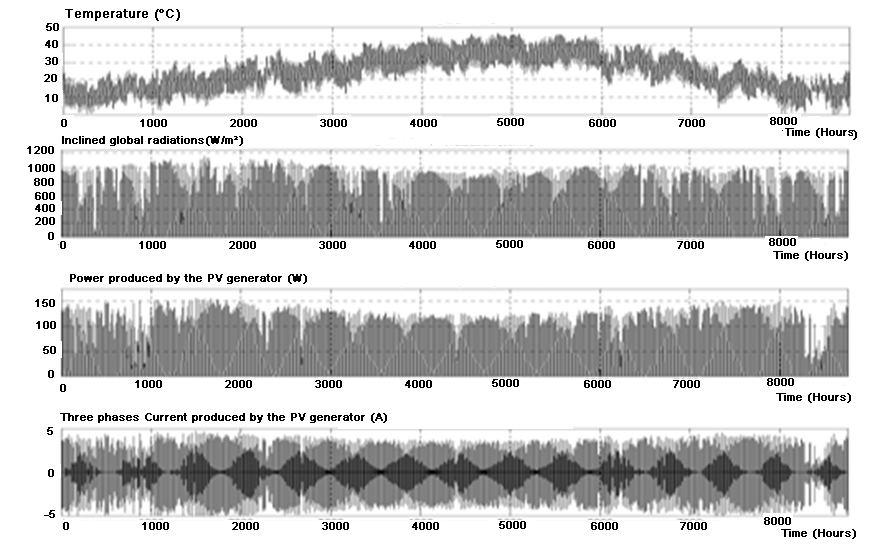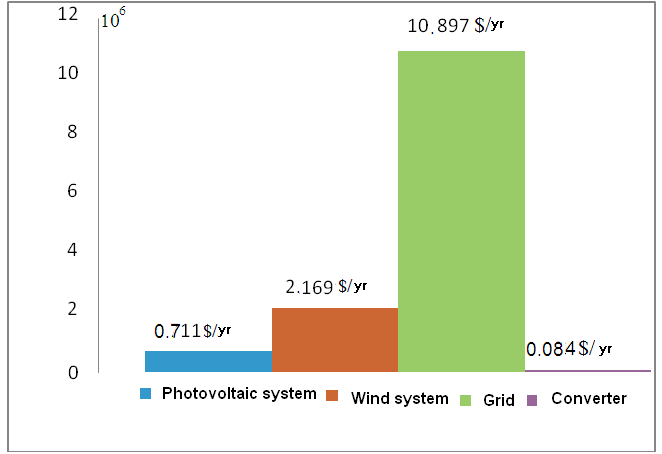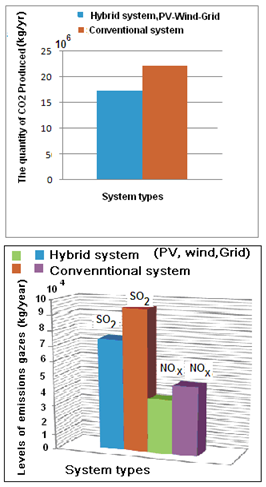-
Paper Information
- Next Paper
- Previous Paper
- Paper Submission
-
Journal Information
- About This Journal
- Editorial Board
- Current Issue
- Archive
- Author Guidelines
- Contact Us
Energy and Power
p-ISSN: 2163-159X e-ISSN: 2163-1603
2012; 2(4): 55-60
doi: 10.5923/j.ep.20120204.03
A Technical, Economic and Environmental Assessment of Decentralized Systems Connected to the Algerian Grid. Case Study: Adrar Site
Djohra Saheb Koussa 1, Mustapha Koussa 1, Seddik Hadji 2
1Centre De DEveloppement Des Energies Renouvelables, BP62 Route De L’Observatoire Bouzareah, Alger 16340, AlgErie
2Laboratoire Des Technologies Industrielle Et De L’Information, UniversitE A. Mira De Bejaia, Targa Ouzemour, Bejaia 06000, Algeria
Correspondence to: Djohra Saheb Koussa , Centre De DEveloppement Des Energies Renouvelables, BP62 Route De L’Observatoire Bouzareah, Alger 16340, AlgErie.
| Email: |  |
Copyright © 2012 Scientific & Academic Publishing. All Rights Reserved.
Abstract This work is aimed to study the wind and photovoltaic power systems connected to the conventional grid. The main interest of such a system is in its own production within the place of consumption, hybridization, and the pooling of resources and the contribution to the environmental protection. To ensure a better management system energy models have been developed for determining the power that subsystems can deliver under given weather conditions Simulation of different subsystems is performed using MATLAB-SIMULINK. The economic and environmental study is developed using the HOMER software. From an economic standpoint, this allows to compare the financial constraints on each system on the Adrar site (27.59N, 0.11W) located in the North-South of Algeria. It also permits to size and select the most optimal system based on two parameters, namely the cost and effectiveness. From an environmental perspective, this study allows us to highlighting the role of renewable energy in reducing emissions of greenhouse gas emissions.
Keywords: Wind, Photovoltaic, Grid, Economy, Environment, MATLAB, HOMER
Article Outline
1. Introduction
- Recently, a growing number of organizations have begun to consider renewable energy and industries related to their production, distribution and services as opportunities rather than regulations[1–6]. Several factors including Kyoto Protocol, alarming reports by Intergovernmental Panel on Climate Change (IPCC) and Copenhagen climate change conference (COP15) have contributed to this change in perspective, and many believe that the trend will continue such that it is of paramount importance to prepare for the ‘‘green race’’ immediately. Algerian government and companies are not exceptions; in fact, they have recently been intensifying efforts towards promoting economic growth via supporting green industries. Examples of such efforts include plans for establishing numerous energy clusters in regions like the proposed wind farm energy production with a capacity of 10 megawatts that were launched in Adrar and the hybrid plant in the region of Hassi R'Mel (Laghouat) made and commissionined since February 2011. Similar projects, environmentally friendly and producing clean and renewable energy, are made available for the areas of Timimoune and Kunta Zaouiet encouraging the use of renewable energy[7,8].However, electrical energy from wind and PV is considered the most promising renewable energy to be developed to replace coal, oil, gas and even nuclear. Anytime, any process of transformation of one form of energy into another usable form is complex. It must integrate a number of advantages and disadvantages of different types, technical, economic and environmental. Thus, the techno - economic and environmental results, presented in this paper allows judging objectively[9].
2. Presentation of the Different Systems of Distributed Generation from Renewable Energy
2.1. Standalone Systems
- For a standalone installation, the energy produced by the photovoltaic solar panels or by the wind generator is used immediately (pumping, ventilation, lighting, refrigerator etc. ) or stored in batteries for later use. The produced current is directly fed to the to the consuming equipment or converted via an inverter to supply devices that require AC power[10,11].
2.2. Multi-Source Hybrid Systems
- These systems supply electricity that is often used at remote sites and are built by coupling different sources of production of electrical energy such as wind, solar and others. They also allow a more reliable supply of electricity. Nearly two billion people are not connected to the utility grid (44% of the world population). Thus, the development of hybrid systems conversion of renewable energy will undoubtedly help to solve many social problems, especially in poor countries and open up vast commercial markets[10] and[12-15].
2.3. Distributed Systems Connected to the Grid
- These are medium and large systems of grid connected [16-19] and running in general over the sun or wind (Fig.1).
 | Figure 1. Decentralized installation connected to the grid |
2.3.1. Problems in the Functioning of Decentralized Systems [20]
- The major difficulty associated with decentralized energy sources is that they generally do not participate in ancillary services (voltage control, frequency, ability to operate in stand-alone mode, etc...). This is especially true for renewable energy sources whose power flow is unpredictable and very volatile. The integration of decentralized generation in networks raises the following problems:- Random and unpredictable production (wind, solar);- Lack of power-frequency control;- No voltage adjustment;- Sensitivity to voltage dips;- Sensitivity to changes in important primary source (wind, solar).The failure to participate in system services brings this type of source to behave as passive generators from the electrical generation point of view. The penetration of distributed generation must be limited by 20 to 30% of the consumed power in order to guarantee acceptable system stability[21].
3. Application Model of a Technical Study and Environmental-Economic Decentralized Systems Connected to the Grid in Algeria. Case Study Adrar
- As an application, the Adrar site has been chosen and the following data are used as input :- The hourly global and diffuse radiation measured on a horizontal plane and the ambient temperature. From the data collected on a horizontal plane, the components of the solar irradiance have been projected on to the surface of a photovoltaic panel. Moreover, the inclination of the used solar panel corresponds to the yearly optimum slope.- The measured wind speeds and the electromechanical characteristics of a wind turbine of the VESTAS 47-660 type. It is a three-blade model with a diameter of 46m, a speed multiplier ratio of 50.5 and the hub height is 100m[22]. Moreover, the power produced by this wind turbine has been calculated using the power curve provided by the manufacturer.
3.1. Power Produced By the Photovoltaic Generator
- For calculating the output characteristics of the photovoltaic system, a program has been developed which requires the global incident radiation and the air temperature as main input data.So, the research unit in renewable energy u.r.e.r. of Adrar provided a full year of hourly measured values of global and diffuse irradiation on a horizontal plane together with those related to the ambient temperature2. From the global radiations on the horizontal plane collected data and based on the equations given in[23], the developed program calculates the overall incident irradiation on the surface of the photovoltaic panel. These latter and the ambient temperatures are used to calculate the power and current delivered by the PV generator. The obtained results are presented in Fig. 2.
3.2. Power Produced By the Wind Generator
- Generally to calculate the power generated by a wind turbine, the data drawn from the main characteristic p=f(v) and supplied by the manufacturer has been used. In this study, using the equations given in[23], the hourly values of wind speed on the Adrar, site are calculated at the hub height of the machine[23]. These are used to determine the machine performance. The results are as follows:• In Fig. 3.a is presented the evolution of hourly wind speeds;• In Fig. 3. b and c are presented respectively the active and reactive power developed at the asynchronous machine;• In Fig. 3.d is presented the current delivered by the windgenerator.
3.3. Electrical Energy Injected into the Grid
- The power delivered by each of the system devices (photovoltaic or wind) should be managed, in such a way that the surplus of power produced by any part of them is conducted to the grid without giving rise to any phenomena leading to a disturbance of any of these devices . For each hour of the year h, the amount of electrical energy available at the transformer connected to the grid is evaluated by[24]:
 | (1) |
 | (2) |
 | Figure 2. Representation of climatic characteristics, power and current produced by the photovoltaic module BP SX 150 S installed on the Adrar site |
 | Figure 3. Simulation results |
 | Figure 4. Flowchart for calculating the amount of power to be inject into the grid |
 | Figure 5. Powers injected into the Grid |
3.4. Total Annual Production
- The contribution of each part of the equipment of the hybrid system (PV-wind-grid) to meet a specific load of 95MWℎ /day with a peak value of 7.7 MW is shown in Fig. 6. It is to be noted that the PV generator produces only 365 MWℎ /year and covers only 1% of the load. The wind generator, in turn, produces 7.225 MW ℎ /year which constitute nearly 21% in coverage against a covered load of 78% (27.225 MWh/year) provided by the conventional electricity grid[25].
 | Figure 6. Structure of the production system (PV-Wind-Grid) |
3.5. Hours of Operation
- Fig.7 represents the operation hours of each of the renewable energy equipments of the hybrid PV-wind-Grid system. It is found that the wind generator section monopolizes the largest parts with a 48% rate of the total, followed by the PV generator and inverter with 26% each one.
 | Figure 7. Distribution of operation hours of each of the renewable energy equipment of the hybrid PV-wind-Grid system |
3.6. Economic Aspects
|
 | Figure 8. Net present cost |
 | Figure 9. Annual Net Cost |
3.7. Environmental Aspects
- The results regarding the environmental effect of each configuration (conventional grid system and hybrid system: Photovoltaic-wind-Grid) obtained and regarding the Adrar site are shown in Fig. 10 [25]. In these figures are presented the quantities of the main gases that are harmful to the environment including CO2, SO2 and NOx. From these results, it is found that the PV-wind-Grid hybrid system produces a reduction rate of the carbon dioxide gas, sulfur dioxide and nitrogen oxide respectively of 20%, 22% and 22% , respectively, compared to the quantities produced by the conventional system [20].
 | Figure 10. The quantities of the polluting gases produced by an hybrid system (PV-wind-Grid) and a conventional system |
4. Conclusions
- This study relates to the technical, economic and environmental impact of decentralized systems coupled to the grid with the appropriate management of energy, through which energy models have been developed.The most significant results are as follows: 1 - The power that any of the sub systems can provide depends on the weather of the considered site;2 - The solar array covers only 1% of the total load consumption. The wind generator contribution rate to energy production is about 21% while 78% are supplied by the conventional electricity grid3 – From an the economic point of view, it is found that for the Adrar site, which is characterized by high wind potential, the hybrid system is competitive with conventional system for a WCC of the energy produced by the network equal to $ 0.4 / kWh as the WCC's hybrid system is equal to $0,399/kWh with an average wind speed greater than or equal to 6 m/s;4 – From an environmental standpoint, emissions of greenhouse gases (CO2, SO2 and NOx) are reduced by 20 to 22% in the case of a hybrid system, compared with the conventional system.
 Abstract
Abstract Reference
Reference Full-Text PDF
Full-Text PDF Full-Text HTML
Full-Text HTML